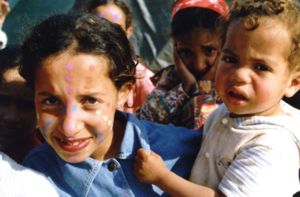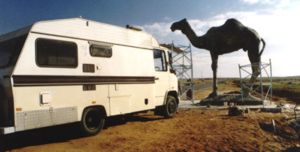
 |

GENERAL
 |
 |
 |

 |
 |
|
 |

 |
 |
|
 |

 |
 |
|
 |

 |
 |
|
 |

 |
 |
|
 |

 |
 |
|
 |

 |
 |
|
 |

 |
 |
|
 |

COMMERCIAL
 |
 |
 |

 |
 |
|
 |

 |
 |
|
 |

INDEPENDENT
 |
 |
 |

 |
 |
|
 |

 |
 |
|
 |

 |
 |
|
 |

 |
 |
|
 |

 |
 |
|
   |
|
 |
Morocco: Travels With Hansi - Part 3
by Cindy Thompson
Sidi Ifini
 Sidi Infi is one of the strangest towns in Morocco, given that it was held by the Spanish until 1969. Having been occupied by the Spanish on and off since 1476 it has a distinctive Iberian appearance, with unusual art deco buildings, which seem out of place from the rest of Moroccan architecture. During its period as a duty free and military zone, the town boasted a busy port and airstrip, both of which are now disused. The old port built by the Spanish, included a concrete island off the coast, which used to be connected to the mainland by a unique cablecar, which carried goods as well as passengers. It has now been replaced by a new port built further south, along side huge sardine and anchovy processing factories. The lighthouse which served the old port still stands proud on the cliff top on the edge of town. The old Spanish prison and airfield also stands empty and disused, though the airport building is now houses a meteorological station. Sidi Ifni is much loved by regular visitors to Morocco, who talk affectionately about their visits, but for me it appeared to have a sad mood, and resembled an aging deserted film set of the rich and famous and in need of some TLC. We stayed on the campsite at the bottom of the cliff, which was very cheap and clean, though be warned, the walk up to the town 300 feet above is hard work. Luckily we had our mopeds! We drove out of Sidi Ifni along the coastal road. The scenery was quite dramatic, with rolling green hills against the back-drop of the Anti-Atlas mountains. Hairpin bends, climbs and drops through villages, oasis and hill top views made an interesting day’s driving, a feat Hansi our truck based Mercedes-Benz, tackled with ease. The turn off to Albeino was a 10km single track from the main road. Abeino is a tiny oasis which has public thermal spring baths. We camped on a small site
which boasted its own thermal baths and intended to soak the evening away. The baths are opened at different times for different sexes. We went in after 6pm, which is mixed bathing. The segregated baths are popular with the locals,
and the mixed popular with tourists. The water is a constant 38 to 40ºC and is shear heaven to plunge into. Outside the campsite is a rich and fertile oasis, which is irrigated by the thermal waters and provides a very pleasant afternoon walk. We would have stayed longer had it not been for the flies. We squished 45 flies in our motorhome before we could retire to bed!
Goulimine
From Abeino we drove onto Goulimine, which our guide books described as “The Gateway to the Sahara” with traditional camel market, and place frequented by the nomadic Blue men. We parked up in town, but failed to see one Blue man, or for that matter a camel! Goulimine reminded us of a border town, with the bustle of traders, a liberal coating of grey dust, to a back drop of drabness, so common at frontiers. It was the furthest south a tourist could travel, as recently as the 1950’s. Beyond Goulimine was the forbidding Sahara Desert. One local told us that the camel market was being held further down the road, today at a village called Sidi Bekku. We decided to investigate. We drove in the general direction but Sidi
Bekku failed to materialise, but we did find a man at the side of the road,
who told us that the very village was the one behind him. Behind him in the distance was a large mud village, surrounded by palm trees. He offered to give us a guided tour. The houses were made of mud, wood and straw, topped with flat roofs. Their gardens were surrounded by high walls. The village had a beautiful rustic feel and looked a little patch of heaven on earth. We were told that the houses had no running water and the inhabitants had to draw all their water from a standpipe in the middle of the village. A couple of houses, not wanting to miss out on any technological advances, had satellite dishes on their roofs. The inhabitants numbered 100, but we only saw two! Our guide then told us that we were indeed f
ortunate that a visiting nomad was in the village and would be happy to receive us as his guests! We were led into a walled enclosure to a blue robed man sitting in a Bedouin tent, who invited us to drink tea. What followed was an Oscar winning performance, of a local dressed as a blue robed man, closely followed by a hard sell of trinkets that littered his tent! Given that the two men were taking their acting roles so seriously, it was funny, and for entertainment value, we played the parts of visiting dignitaries admirably.
Tan Tan
 The road to Tan Tan was a barren stretch of 125kms of semi arid desert. Large sand dunes were now a common sight, giving the feel that we were now truly on the edge of the Sahara Desert. Sometimes we saw people sitting in the middle of nowhere, waiting! Where they had come from and where they were going, was a mystery. The entry into Tan Tan is marked by the famous art deco kissing camels, which stand facing each other arching over the road, meeting with a kiss. We arrived to find them missing! In their place two new camels were being sculptured, which were far more life-like and impressive. We stopped for a photo shoot, only to be surrounded by a horde of school children, earnestly begging for ‘Une bon bon, un
e stilo, une cadeau.’ (sweet, biro and gift) I wanted to give them a gift of ‘une clip round the ear.’ They all went quiet when I asked them in Arabic why they were not in school, then sheepishly slinked away. We went and parked on Tan Tan Plage, where there were 10 other motorhomes and an old but very friendly parking attendant. He told me in Arabic that the market was on a Thursday and that I must be Egyptian! He was right, my accent is Egyptian as the year abroad of my Arabic degree was spent in Egypt. We didn’t go into Tan Tan, but left the following morning to head North again. It was as far south as we were going on this trip, as we left England later than usual this winter. Our plans are to drive further south next year.
No not kissing camels, but kissing trucks!

The drive back Goulimine was uneventful, after which we took the P30 road onto Tiznit. The first third of the road was semi arid desert scrub land, but became much more dramatic and greener just before the 1057M Tizi Mighert pass, which cut through the end of the Anti Atlas hugging the mountain sides. Luckily we were travelling with the open sheer drops on the opposite side of the road. As we snaked up and around the hair-pin bends in third gear, we had a big shock. Turning the rock face of one of the blind bends, we were greeted by a long nosed Volvo truck pulling a long trailer on our side of the road! He had nowhere to go as he was overtaking three other trucks, and we only had sheer rock face in which to disappear! (chan
ge of knickers please!) My husband slammed on Hansi’s breaks, and thankfully as we were only in third gear, going up hill, we were able to stop quickly. I was busy gesturing ‘ You ******!’ as the trucker pulled back in to his side of the road with inches to spare. The driver gave me a cheeky smile as his truck almost kissed our bumper. Thankfully my husband has good evasive driving skills and we narrowly missed what could have been a messy encounter. As an after thought, I wondered if he was performing the Moroccan tea making ceremony and as a result had a lapse of concentration. I giggled at the thought of the BBC reporting on the 10 O’Clock news that performing the English tea making ceremony whilst driving is to be a finable offence, which could also incur a driving ban. The announcement would be followed by ‘experts’ providing an in-depth report of the findings of their very costly research, on how the logistics of such multi tasking could cause a lapse of concentration, especially during the swilling of the tea bag or the addition of spoonfuls of sugar.
We made it back to Tiznit campsite, to find the French Boules championship still in full swing, having been extended a further full week in order to conquer some feisty, late English and Swiss entrants. |
 |
|











